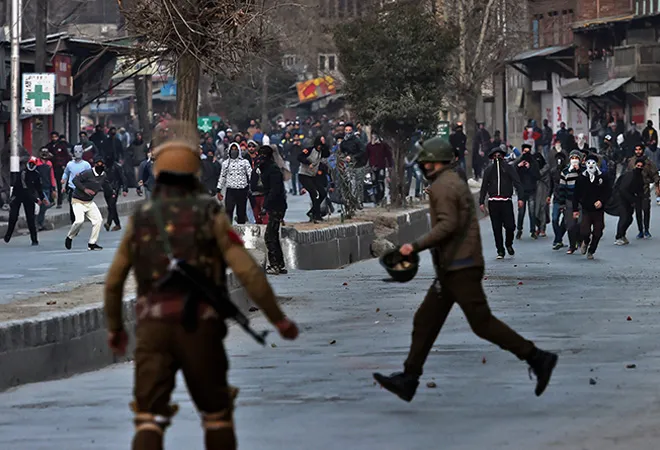
In recent years, militancy in the valley of Kashmir has risen to alarming proportions. While for decades Kashmir has been a victim of Pakistan-sponsored terrorism, the turn of events, especially since 2016, has seen a steady rise in home-bred insurgency, with hundreds of local boys joining militancy ranks.
Apparently, New Delhi’s eye for an eye strategy in handling the situation through Operation All-Out seems to have become a zero-sum game for India. On the other hand, the valley seems to have been caught in the crosshairs of the worsening ‘conflict in Kashmir’ owing to the upsurge of insurgency on the one side, and the intensified ‘conflict over Kashmir,’ – which has witnessed an unprecedented increase of ceasefire violations by Pakistan along the Line of Control (LoC) – on the other. The ongoing crises has led the Kashmir Valley, particularly its youth, to the crossroads of a social, cultural, moral and intellectual anarchy.
In Kashmir, aazadi (freedom) and political aims have always been sought to be achieved with the help of Pakistan-sponsored guns. In the recent past, however, the profile of terrorists, and indeed of terrorism too, has undergone rapid transformation. Terrorism in the valley no longer needs hired guns.
The new generation of terrorists are comprised of radicalised local youth, who are causing more harm to their own society than to their perceived adversary i.e. the Indian state. They are motivated and tech-savvy, unlike their predecessors. They see dignity in death – going down fighting the combined might of the military and other security forces. And there is a complete lack of realisation that Kashmir’s agony is not only on account of grave political commissions and omissions of the Centre and the State, but also because of self-inflicted injuries.
According to latest media reports, over 55 terrorists have been killed in the first four months of 2018, of which, 27 were local recruits. Against those killed, 45 new local boys – nearly double the number – joined terror groups during the same period.
In Kashmir, Indian security forces have adopted a strategy of decapitation based on the view that elimination of the leadership will eliminate the very phenomenon of terrorism. The decapitation strategy works at two levels: one, eliminating the leadership and two, as a consequence, destroying the organisation (ideology) itself. Neither appears to be within New Delhi’s reach. The strategy couldn’t have been more misplaced, as contrary to its objectives, it has created an environment for terrorism to flourish. The sheer numbers in which the youth have embraced militancy has shown that there is no link between dead terrorists and no terrorism. And far from being stopped, despite unparalled success in eliminating high-profile targets, the intensity of and inspiration toward terrorism has swelled.
This strategy of targeting the organisational leadership has tacitly promoted them as cult heroes. When eliminated, their ‘martyrdom’ becomes a source of inspiration for more and more youth to follow their path of violence.
There are no doubts about India’s intention of eliminating terrorism from the valley and that the use of pellets and bullets has become a military necessity. But any prolonged use of excessive force is bound to lose its meaning and impact, as shown by the Kashmiri youth, who have become increasingly disregarding of the grave consequences their actions invite. At no time in the past decades has the Kashmir conflict witnessed local residents, both men and women, fearlessly rush toward encounter sites to thwart anti-insurgency operations – unarmed, risking their own lives by facing a volley of bullets and pellets. The video of the mother of slain Hizbul Mujahideen commander Saddam Paddar giving a ‘gun salute’ to her son by firing gunshots in the air using an AK-47 rifle clearly indicates that the phenomenon of insurgency in the valley has penetrated deep into the mindset of the family – the basic unit of society. The victims of terrorism have become protectors of terrorists.
This desperate situation demonstrates that not only has this new phenomenon of insurgency established strong roots in the social psyche of the valley, but it has also provided fertile ground to foster further militancy in the form of ready and willing new recruits to take the place of slain militants. It is high time New Delhi realised that killing terrorists – who are as much Indians as they are Kashmiris – will certainly not eliminate terrorism.
Terror commanders have emerged as cult figures. They continue to inspire their peers from their graves. The memories of the slain terrorists are kept alive and burning in the social mind space. Their past lives and struggles are glorified and they become a rallying force for the inner circle of believers – promising them a bright future through armed struggle. Bright future in the world of terror? There can’t be a bigger myth than this. However, guile and contempt are an integral part of establishing a cult and maintaining the god-like image of the cult leader. It unites the masses and gives them a collective identity. Bigger the myth, bigger is the following. In Kashmir, there is no bigger myth than martyrdom in the name of god and aazadi.
The current rising number of new terror recruits is akin to the mythical episode of the demon called Raktabija (blood-seed) mentioned in Markanday Purana, an ancient Indian religious text.
Raktabija was blessed by Lord Brahma that every drop of his blood will create a new demon as it falls on the ground. After causing much destruction, Raktabija is said to have been killed by the goddess Kali, who drank all the blood spilled by him. Kashmir, however, is not a battle between demons and gods and, by extension, between the good and the evil. We are dealing with a society upon whom extremism was imposed, which now, thanks to misguided strategies and lack of self-introspection, has resulted in an identity crisis for the Kashmir valley.
Since 1989, Kashmiris have lived under the fear of the gun, whether it is that of the militants or the military. Decades of human rights violations that the society has witnessed it has manifested itself in the form a deep psychological trauma of its people. A large number of Kashmiri youth, either as militants, or under the suspicion of being militants or sympathisers have been arrested or just disappeared. The disappearance of the youth, torture to extract information during interrogation, the Machil encounter of 2010 and indiscriminate use of pellet guns since 2016 have damaged New Delhi’s case in Kashmir.
Pakistan’s silence over the new wave of trouble in Kashmir is conspicuous. Islamabad appears to be having the last laugh as evidently, it is New Delhi with its lopsided policy – and not Islamabad per se – that has converted the cross-border terrorism into India’s full-blown internal insurgency problem.
As the situation in the Kashmir Valley has dramatically turned worse, the government must open channels of dialogue with all sections of the Kashmiri society without any preconditions, while the latter needs to realise that violence is no solution to their political aspirations. Kashmir urgently needs strong socio-political leadership that can create an alternative narrative to terrorism and help the Kashmiri society realise the cost it has paid by embracing the gun.
The author is a Fellow at ORF Mumbai.
The views expressed above belong to the author(s). ORF research and analyses now available on Telegram! Click here to access our curated content — blogs, longforms and interviews.




 PREV
PREV


